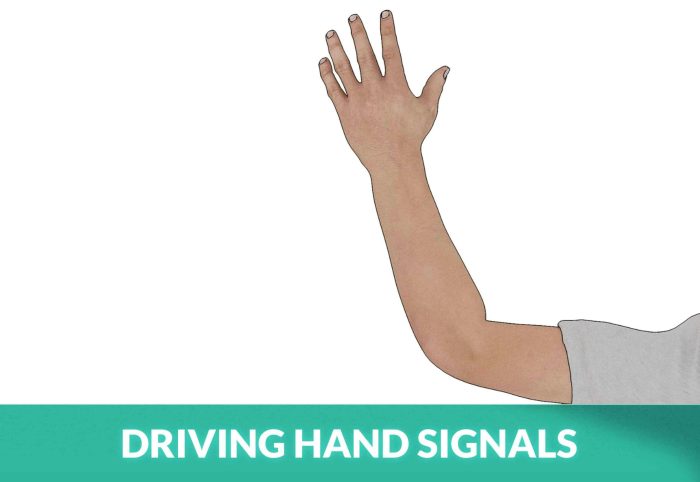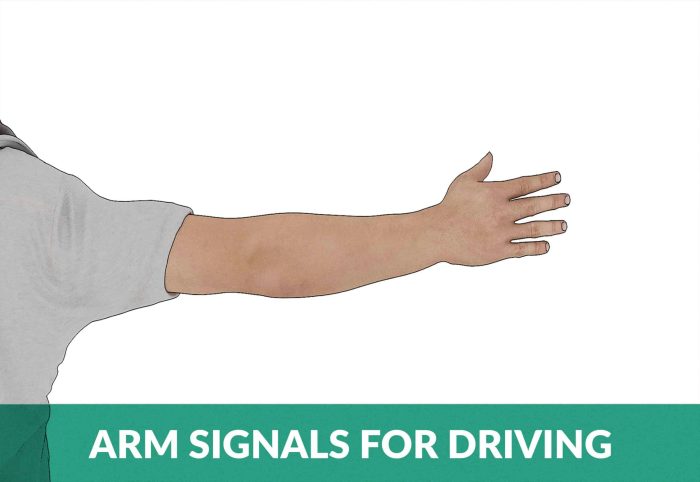The drivers left arm and hand are extended upward – The driver’s left arm and hand extended upward is a common posture while driving, but it is crucial to understand the biomechanics, ergonomics, and safety implications of this position. This article delves into the significance of maintaining proper alignment, hand positioning, and steering techniques to ensure optimal control, comfort, and safety behind the wheel.
Posture and Alignment

When the driver’s left arm and hand are extended upward, the body assumes a specific posture and alignment. The arm is typically slightly bent at the elbow, with the forearm and hand positioned approximately parallel to the ground. The shoulder is abducted (lifted sideways) and externally rotated, while the scapula (shoulder blade) is retracted (pulled backward).
This posture helps to maintain a comfortable and stable driving position, ensuring optimal control and visibility.
Anatomically, the muscles involved in this posture include the deltoids (shoulder muscles), supraspinatus (rotator cuff muscle), and trapezius (upper back muscle). The shoulder joint, elbow joint, and wrist joint are also crucial in maintaining proper alignment and posture.
Maintaining proper alignment and posture while driving is essential for several reasons. It promotes comfort, reduces fatigue, and improves steering control. It also helps to prevent musculoskeletal injuries, such as neck pain, shoulder pain, and back pain, which can result from prolonged driving in an improper position.
Hand and Finger Position
When the left arm is extended upward, the hand and fingers should be positioned correctly on the steering wheel to ensure optimal steering control and vehicle stability. The ideal hand position is with the left hand at the “9 o’clock” position and the right hand at the “3 o’clock” position.
The hands should be relaxed and slightly cupped, with the fingers curled over the rim of the steering wheel. The thumbs should be positioned at the sides of the wheel, facing each other.
Proper hand and finger placement allows for precise and responsive steering inputs. It also helps to distribute the force exerted on the steering wheel evenly, reducing strain on the wrists and forearms. Incorrect hand and finger placement, such as gripping the wheel too tightly or using only one hand, can compromise steering control and increase the risk of accidents.
Steering Techniques

The extended left arm and hand play a crucial role in performing various steering maneuvers. In straight-line driving, the hands should remain at the “9 o’clock” and “3 o’clock” positions, with slight adjustments made as needed. For gentle curves, the hands can be moved slightly in the direction of the turn, while for sharper curves, the hands may need to be crossed over.
Different steering techniques may be employed depending on the situation and arm position. For example, the “hand-over-hand” technique involves moving the hands alternately over the steering wheel for precise control in tight turns. The “push-pull” technique, on the other hand, involves pushing the steering wheel in one direction while simultaneously pulling it in the opposite direction, which is useful for quick maneuvers.
In situations where the steering wheel needs to be turned quickly or significantly, such as in emergency maneuvers or evasive actions, the extended left arm allows for rapid and forceful inputs. The driver can use the extended arm as a lever, providing greater leverage and control over the steering wheel.
Ergonomics and Comfort
Maintaining the left arm and hand in an extended upward position for extended periods can have ergonomic implications. Prolonged static postures can lead to discomfort, muscle fatigue, and potential strain injuries. Drivers who spend many hours behind the wheel may experience neck pain, shoulder pain, and back pain if they do not maintain proper posture and adjust their driving position regularly.
To minimize discomfort and promote long-term health, drivers should make adjustments to their seating position and steering wheel height to ensure that the left arm and hand are in a comfortable and neutral position. Regular breaks from driving and stretching exercises can also help to reduce muscle fatigue and prevent discomfort.
Safety Considerations
Maintaining an extended left arm and hand while driving has safety implications as well. In the event of a collision or sudden stop, the driver’s body may be subjected to significant forces. An extended arm and hand can be more vulnerable to injuries, such as fractures, dislocations, or sprains.
To mitigate these risks, drivers should always wear a seatbelt and ensure that the steering wheel is adjusted to a proper height and distance. Proper posture and hand positioning can help to minimize the risk of injuries and enhance overall driving safety.
Driver Education and Training

Educating drivers about the proper use of the left arm and hand when driving is essential for promoting safe and comfortable driving practices. Driver education programs should include instruction on proper posture, hand and finger placement, and steering techniques.
Driving simulators and other training aids can be effective tools for teaching and reinforcing good posture and steering habits. These tools allow drivers to practice in a controlled environment, receiving immediate feedback on their technique and identifying areas for improvement.
FAQ Guide: The Drivers Left Arm And Hand Are Extended Upward
Why is it important to maintain proper alignment while driving?
Maintaining proper alignment is crucial for optimal posture, reducing strain and fatigue, and ensuring precise vehicle control.
How does hand position affect steering control?
Hand position on the steering wheel directly influences the driver’s ability to steer accurately and respond quickly to road conditions.
What are the potential risks associated with incorrect hand and finger placement?
Incorrect hand and finger placement can lead to reduced steering control, increased risk of injury in the event of a collision, and discomfort or pain over time.